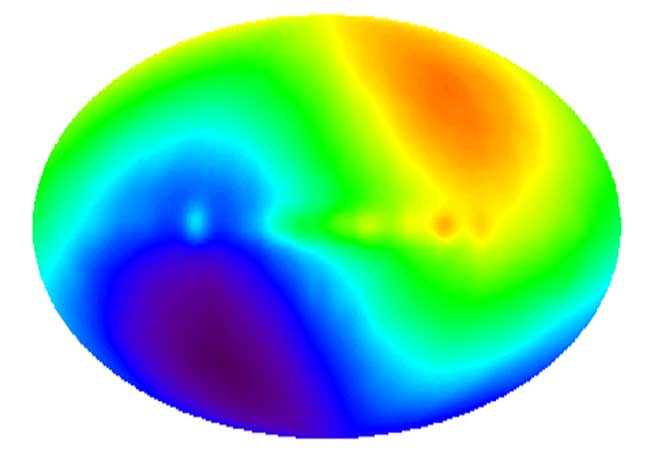
"Fig. 6. Radial acceleration ar; PE storage at 0.16 solar radius facing the barycentre (PEv), and the observed sunspots series (SN). The particular dynamics around the impulsive events produce a dramatic decrease of the hypothetic PE in the studied solar zone. The ‘X’ symbol marks the minima in PEv values; they occur ~1593–1632-1670; ~1772–1811-1850; ~1951-1990–2030 (see the text for explanation [Page 8/12]). Acceleration reckoning in UA d2. PEv plot in logarithmic scale." - Excerpt from the paper on page 9/12.
From the barycentric perspective, when the PEv values were low (marked X) as a result of the Sun was very near to the quasi SSB during the troughs of the solar minima in 1650 (Wolf number) and SC6 (SIDC) in 1811, there were occurrences of the grand solar minima during the troughs of these solar cycles, and for the solar minimum of SC26 in 2030 the PEv value would also be at a low value. When those PEv values were low during the peaks of the solar maxima of SC2, SC9, SC18, SC22, there was no occurrence of any grand solar minimum at all.
The ~20 year integral cycle of Sun, Jupiter, and Saturn, interacting with the ~11 year half-integral cycle in the barycentric alignments of Jupiter and Saturn barycenter, Sun, and BOTSS, would generate the ~220 year (20x11) long-range half cycle.
Heuristically, the commencing of the solar cycle 25 should result in the sunspot numbers to rise in the coming years until it reaches the solar maximum. Nonetheless, the peak of this solar cycle 25 could be expected to be as low as the solar maximum of the solar cycle 05, which happened in Feb 1805 at 220 years ago from the solar maximum of the solar cycle 05. And towards the end of the solar cycle 25, with its comparable position of BOTSS positioned near the mass center of the Sun, it could manifest a Grand Solar minimum of a lesser Dalton minimum magnitude with the near position during the solar cycle trough in 2030.
This solar minimum anticipated to happen around 2030 with the near superior conjunction of Saturn-Sun-Jupiter, could be anticipated to be prolonged at around the trough at the end of the solar cycle 25. And this prolonged trough of the solar minimum would be similar to the solar minimum of the solar cycle 06 that had begun in Aug 1810 with the superior conjunction of Saturn-Sun-Jupiter formed in around 1812. And thus the mass center of the Sun was cyclically positioned at the closest point to the barycenter of the Solar System with Uranus and Neptune positioned at the side of Saturn away from Jupiter and the Sun.
The year 1812 was the beginning of the coldest years that last until 1818 during the Dalton minimum (roughly between 1790 and 1830). Despite 1816 was remembered as the year without summer, but that year was not the coldest year between 1812 and 1818.
From the barycentric perspective, the trough period of the Grand Solar Minimum occurring during the anticipated solar minimum in February 2030, is the recurrence of a 220-year long-range solar cycle as a result of a long period barycentric alignment of the four gas giants with the mass center of the Sun and the barycenter of the Solar System. As a result of the near superior conjunction of Saturn-Sun-Jupiter during the anticipated solar minimum with Uranus and Neptune positioned at the side of Saturn away from Jupiter and the Sun, the mass center of the Sun would cyclically approach very near to the barycenter of the Solar System in late March 2030, which would coincide with the trough period the solar cycle 26 around its solar minimum.
The full-blown effects of the 220-year long-range solar cycle occurring to Earth after the solar maximum in October 2023, could be expected to begin thereafter till it reaches the deepest trough of the anticipated Grand Solar Minimum in late March 2030 when the mass center of the Sun approaches very near to the barycenter of the Solar System, and its effects would then oscillate to wean off thereon.
From the barycentric perspective, a Grand Solar Minimum is indeed imminent.










